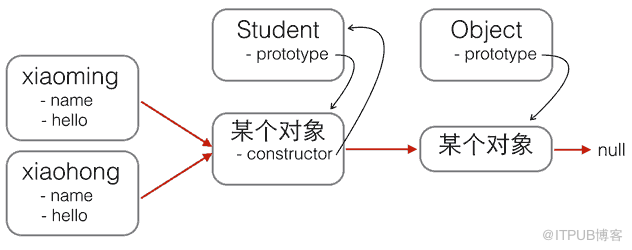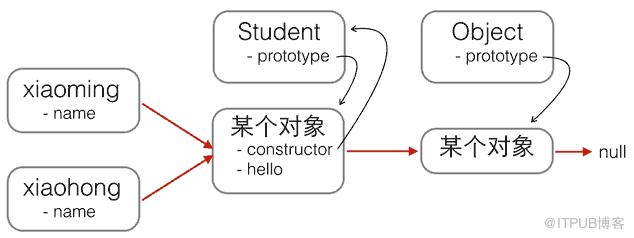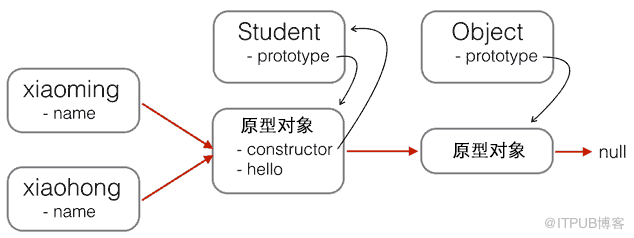这篇文章主要讲解了“分析HTML5开发中js的创建和继承”,文中的讲解内容简单清晰,易于学习与理解,下面请大家跟着小编的思路慢慢深入,一起来研究和学习“分析HTML5开发中js的创建和继承”吧!
当我们用obj.xxx访问一个对象的属性时,JavaScript引擎先在当前对象上查找该属性,如果没有找到,就到其原型对象上找,如果还没有找到,就一直上溯到Object.prototype对象,最后,如果还没有找到,就只能返回undefined。
例如,创建一个Array对象:
var arr = [1, 2, 3];
其原型链是:
arr ----> Array.prototype ----> Object.prototype ----> null
Array.prototype定义了indexOf()、shift()等方法,因此你可以在所有的Array对象上直接调用这些方法。
当我们创建一个函数时:
function foo() {
return 0;
}
函数也是一个对象,它的原型链是:
foo ----> Function.prototype ----> Object.prototype ----> null
由于Function.prototype定义了apply()等方法,因此,所有函数都可以调用apply()方法。
很容易想到,如果原型链很长,那么访问一个对象的属性就会因为花更多的时间查找而变得更慢,因此要注意不要把原型链搞得太长。
构造函数
除了直接用{ ... }创建一个对象外,JavaScript还可以用一种构造函数的方法来创建对象。它的用法是,先定义一个构造函数:
function Student(name) {
this.name = name;
this.hello = function () {
alert('Hello, ' + this.name + '!');
}
}
你会问,咦,这不是一个普通函数吗?
这确实是一个普通函数,但是在JavaScript中,可以用关键字new来调用这个函数,并返回一个对象:
var xiaoming = new Student('小明');
xiaoming.name; // '小明'
xiaoming.hello(); // Hello, 小明!
注意,如果不写new,这就是一个普通函数,它返回undefined。但是,如果写了new,它就变成了一个构造函数,它绑定的this指向新创建的对象,并默认返回this,也就是说,不需要在最后写return this;
新创建的xiaoming的原型链是:
xiaoming ----> Student.prototype ----> Object.prototype ----> null
也就是说,xiaoming的原型指向函数Student的原型。如果你又创建了xiaohong、xiaojun,那么这些对象的原型与xiaoming是一样的:
xiaoming ↘
xiaohong -→Student.prototype ----> Object.prototype ----> null
xiaojun ↗
用new Student()创建的对象还从原型上获得了一个constructor属性,它指向函数Student本身:
xiaoming.constructor === Student.prototype.constructor; // true
Student.prototype.constructor === Student; // true
Object.getPrototypeOf(xiaoming) === Student.prototype; // true
xiaoming instanceof Student; // true

看晕了吧?用一张图来表示这些乱七八糟的关系就是:
红色箭头是原型链。注意,Student.prototype指向的对象就是xiaoming、xiaohong的原型对象,这个原型对象自己还有个属性constructor,指向Student函数本身。
另外,函数Student恰好有个属性prototype指向xiaoming、xiaohong的原型对象,但是xiaoming、xiaohong这些对象可没有prototype这个属性,不过可以用__proto__这个非标准用法来查看。
现在我们就认为xiaoming、xiaohong这些对象“继承”自Student。
不过还有一个小问题,注意观察:
xiaoming.name; // '小明'
xiaohong.name; // '小红'
xiaoming.hello; // function: Student.hello()
xiaohong.hello; // function: Student.hello()
xiaoming.hello === xiaohong.hello; // false
xiaoming和xiaohong各自的name不同,这是对的,否则我们无法区分谁是谁了。
xiaoming和xiaohong各自的hello是一个函数,但它们是两个不同的函数,虽然函数名称和代码都是相同的!
如果我们通过new Student()创建了很多对象,这些对象的hello函数实际上只需要共享同一个函数就可以了,这样可以节省很多内存。

要让创建的对象共享一个hello函数,根据对象的属性查找原则,我们只要把hello函数移动到xiaoming、xiaohong这些对象共同的原型上就可以了,也就是Student.prototype:
修改代码如下:
function Student(name) {
this.name = name;
}
Student.prototype.hello = function () {
alert('Hello, ' + this.name + '!');
};
用new创建基于原型的JavaScript的对象就是这么简单!
忘记写new怎么办
如果一个函数被定义为用于创建对象的构造函数,但是调用时忘记了写new怎么办?
在strict模式下,this.name = name将报错,因为this绑定为undefined,在非strict模式下,this.name = name不报错,因为this绑定为window,于是无意间创建了全局变量name,并且返回undefined,这个结果更糟糕。
所以,调用构造函数千万不要忘记写new。为了区分普通函数和构造函数,按照约定,构造函数首字母应当大写,而普通函数首字母应当小写,这样,一些语法检查工具如jslint将可以帮你检测到漏写的new。
最后,我们还可以编写一个createStudent()函数,在内部封装所有的new操作。一个常用的编程模式像这样:
function Student(props) {
this.name = props.name || '匿名'; // 默认值为'匿名'
this.grade = props.grade || 1; // 默认值为1
}
Student.prototype.hello = function () {
alert('Hello, ' + this.name + '!');
};
function createStudent(props) {
return new Student(props || {})
}
这个createStudent()函数有几个巨大的优点:一是不需要new来调用,二是参数非常灵活,可以不传,也可以这么传:
var xiaoming = createStudent({
name: '小明'
});
xiaoming.grade; // 1
如果创建的对象有很多属性,我们只需要传递需要的某些属性,剩下的属性可以用默认值。由于参数是一个Object,我们无需记忆参数的顺序。如果恰好从JSON拿到了一个对象,就可以直接创建出xiaoming。
继承
在传统的基于Class的语言如Java、C++中,继承的本质是扩展一个已有的Class,并生成新的Subclass。
由于这类语言严格区分类和实例,继承实际上是类型的扩展。但是,JavaScript由于采用原型继承,我们无法直接扩展一个Class,因为根本不存在Class这种类型。
但是办法还是有的。我们先回顾Student构造函数:
function Student(props) {
this.name = props.name || 'Unnamed';
}
Student.prototype.hello = function () {
alert('Hello, ' + this.name + '!');

}
以及Student的原型链:
现在,我们要基于Student扩展出PrimaryStudent,可以先定义出PrimaryStudent:
function PrimaryStudent(props) {
// 调用Student构造函数,绑定this变量:
Student.call(this, props);
this.grade = props.grade || 1;
}
但是,调用了Student构造函数不等于继承了Student,PrimaryStudent创建的对象的原型是:
new PrimaryStudent() ----> PrimaryStudent.prototype ----> Object.prototype ----> null
必须想办法把原型链修改为:
new PrimaryStudent() ----> PrimaryStudent.prototype ----> Student.prototype ----> Object.prototype ----> null
这样,原型链对了,继承关系就对了。新的基于PrimaryStudent创建的对象不但能调用PrimaryStudent.prototype定义的方法,也可以调用Student.prototype定义的方法。
如果你想用最简单粗暴的方法这么干:
PrimaryStudent.prototype = Student.prototype;
是不行的!如果这样的话,PrimaryStudent和Student共享一个原型对象,那还要定义PrimaryStudent干啥?
我们必须借助一个中间对象来实现正确的原型链,这个中间对象的原型要指向Student.prototype。为了实现这一点,参考道爷(就是发明JSON的那个道格拉斯)的代码,中间对象可以用一个空函数F来实现:
// PrimaryStudent构造函数:
function PrimaryStudent(props) {
Student.call(this, props);
this.grade = props.grade || 1;
}
// 空函数F:
function F() {
}
// 把F的原型指向Student.prototype:
F.prototype = Student.prototype;
// 把PrimaryStudent的原型指向一个新的F对象,F对象的原型正好指向Student.prototype:
PrimaryStudent.prototype = new F();
// 把PrimaryStudent原型的构造函数修复为PrimaryStudent:
PrimaryStudent.prototype.constructor = PrimaryStudent;
// 继续在PrimaryStudent原型(就是new F()对象)上定义方法:
PrimaryStudent.prototype.getGrade = function () {
return this.grade;
};
// 创建xiaoming:
var xiaoming = new PrimaryStudent({
name: '小明',
grade: 2
});
xiaoming.name; // '小明'
xiaoming.grade; // 2
// 验证原型:
xiaoming.__proto__ === PrimaryStudent.prototype; // true
xiaoming.__proto__.__proto__ === Student.prototype; // true
// 验证继承关系:
xiaoming instanceof PrimaryStudent; // true
xiaoming instanceof Student; // true

用一张图来表示新的原型链:
注意,函数F仅用于桥接,我们仅创建了一个new F()实例,而且,没有改变原有的Student定义的原型链。
如果把继承这个动作用一个inherits()函数封装起来,还可以隐藏F的定义,并简化代码:
function inherits(Child, Parent) {
var F = function () {};
F.prototype = Parent.prototype;
Child.prototype = new F();
Child.prototype.constructor = Child;
}
这个inherits()函数可以复用:
function Student(props) {
this.name = props.name || 'Unnamed';
}
Student.prototype.hello = function () {
alert('Hello, ' + this.name + '!');
}
function PrimaryStudent(props) {
Student.call(this, props);
this.grade = props.grade || 1;
}
// 实现原型继承链:
inherits(PrimaryStudent, Student);
// 绑定其他方法到PrimaryStudent原型:
PrimaryStudent.prototype.getGrade = function () {
return this.grade;
};
小结
JavaScript的原型继承实现方式就是:
定义新的构造函数,并在内部用call()调用希望“继承”的构造函数,并绑定this;
借助中间函数F实现原型链继承,最好通过封装的inherits函数完成;
继续在新的构造函数的原型上定义新方法。
ES6的class继承
新的关键字class从ES6开始正式被引入到JavaScript中。class的目的就是让定义类更简单。
我们先回顾用函数实现Student的方法:
function Student(name) {
this.name = name;
}
Student.prototype.hello = function () {
alert('Hello, ' + this.name + '!');
}
如果用新的class关键字来编写Student,可以这样写:
class Student {
constructor(name) {
this.name = name;
}
hello() {
alert('Hello, ' + this.name + '!');
}
}
比较一下就可以发现,class的定义包含了构造函数constructor和定义在原型对象上的函数hello()(注意没有function关键字),这样就避免了Student.prototype.hello = function () {...}这样分散的代码。
最后,创建一个Student对象代码和前面章节完全一样:
var xiaoming = new Student('小明');
xiaoming.hello();
class继承
用class定义对象的另一个巨大的好处是继承更方便了。想一想我们从Student派生一个PrimaryStudent需要编写的代码量。现在,原型继承的中间对象,原型对象的构造函数等等都不需要考虑了,直接通过extends来实现:
class PrimaryStudent extends Student {
constructor(name, grade) {
super(name); // 记得用super调用父类的构造方法!
this.grade = grade;
}
myGrade() {
alert('I am at grade ' + this.grade);
}
}
注意PrimaryStudent的定义也是class关键字实现的,而extends则表示原型链对象来自Student。子类的构造函数可能会与父类不太相同,例如,PrimaryStudent需要name和grade两个参数,并且需要通过super(name)来调用父类的构造函数,否则父类的name属性无法正常初始化。
PrimaryStudent已经自动获得了父类Student的hello方法,我们又在子类中定义了新的myGrade方法。
ES6引入的class和原有的JavaScript原型继承有什么区别呢?实际上它们没有任何区别,class的作用就是让JavaScript引擎去实现原来需要我们自己编写的原型链代码。简而言之,用class的好处就是极大地简化了原型链代码。
感谢各位的阅读,以上就是“分析HTML5开发中js的创建和继承”的内容了,经过本文的学习后,相信大家对分析HTML5开发中js的创建和继承这一问题有了更深刻的体会,具体使用情况还需要大家实践验证。这里是亿速云,小编将为大家推送更多相关知识点的文章,欢迎关注!
免责声明:本站发布的内容(图片、视频和文字)以原创、转载和分享为主,文章观点不代表本网站立场,如果涉及侵权请联系站长邮箱:is@yisu.com进行举报,并提供相关证据,一经查实,将立刻删除涉嫌侵权内容。